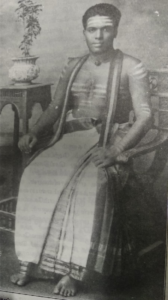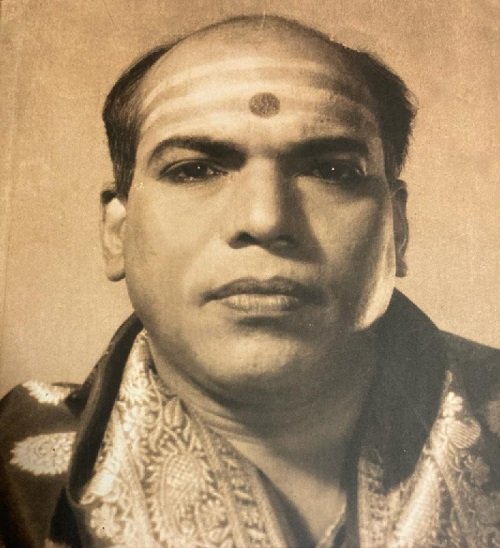Read in : தமிழ்
SG Kittappa is a legendary figure in the music world. His extraordinarily dexterous voice sent listeners into a rapture. His early death gave him a legendary status. But, even legends have teachers and their stories can illuminate, too.
Kittappa’s teacher was Mariappasamy, whom the people called Tamilisai Thavamani for being among the earliest votaries of Tamil music. Mariappasamy could sing an entire concert in Tamil long before Tamilisai became a genre and was advocated by noted musicians including MS Subbulakshmi.
Born in Madurai in 1902 to Poochan Chettiar and Alamelumangai, Mariappasamy joined Velu Nair’s Shanmugananda Boys Company. The drama troupe’s trainer was another legend of Tamil theatre – Sankaradas Swamigal.
Sankaradas Swamigal taught acting as well as singing to budding theatre artistes. Since Mariappasami excelled in both he soon became adjunct faculty to Sankaradas Swamigal, teaching budding artistes younger than him. When Kittappa joined the troupe, he was four years younger to Mariappasami. Along with Kittappa, PT Chidambaram, MS Muthukrishnan, Yathartham Ponnusamy Pillai, SV Venkatraman and MR Radha learned from Mariappasamy.
A stern teacher, Mariappasamy would not hesitate to slap kids if they made mistakes. Sankaradas Swamigal, a saintly figure, seemed to have a foreboding of Kittappa’s early death, Mariappasamy has said. Swamigal would admonish Mariappasamy if he beat Kittappa saying Kittappa was going to have a short life.
Sankaradas Swamigal, a saintly figure, seemed to have a foreboding of Kittappa’s early death, Mariappasamy has said. Swamigal would admonish Mariappasamy if he beat Kittappa saying Kittappa was going to have a short life
In the Boys Company hierarchy, an artiste aspires to be a Rajapart, the acting-singing star who can play the lead role. Mariappasamy came to that level when he was barely 15 years old. He was a pioneer in introducing Hindustani music elements into his singing.
Christened Mariappan, he was called Mariappasamy because he took sanyas – renunciate. The politics, backbiting, and jealousy of the drama world turned him towards asceticism.
In 1926, he published a book called “Senthil Andavan Kirtanai” containing songs devoted to Lord Muruga. Besides four kirtanais, three for Lord Ganesha and one for his Guru who initiated him, Sugunanda Swami, all other kirtanais were for Lord Muruga.
 Mariappa started giving public performances from 1923. Many of the songs he sang were his own compositions while he would include compositions of Vallalar, Arunagirinathan, Thayumanavar and others.
Mariappa started giving public performances from 1923. Many of the songs he sang were his own compositions while he would include compositions of Vallalar, Arunagirinathan, Thayumanavar and others.
A characteristic of his compositions was the Sandham that would come after the Pallavi-Anupallavi-Saranam. In Carnatic music, the Saranam is sometimes followed by the performer singing the Swaras as per various rhythms (talams). Sandham involves sounds set to rhythms where the Swara is not pronounced as such. This became the Mariappasamy style (bani). The style would combine the Swara singing with phrases that set the rhythm. This was a rather unique style, says VPK Sundaram, an expert in Tamilisai.
Samy’s singing was such that the words would be given due importance. He wouldn’t mangle or sacrifice the integrity of words for the sake of exhibiting his grasp of musical nuances. This meant his performance was as much about conveying the meaning of the words. His sangathis were not extensive but would be such that they brought out the meaning of the words as much as they exhibited the characteristics of the ragams. This often had a mesmeric effect on listeners. With his voice, he would capture the attention of large audiences.
Samy’s singing was such that the words would be given due importance. He wouldn’t mangle or sacrifice the integrity of words for the sake of exhibiting his grasp of musical nuances
While his concerts in general would contain his compositions, he would sing Arunagirinathar songs if it was a Tiruppugazh sabha or Thiruvarutpas if it was an Arutpa festival. Compositions for Lord Ganesha, such as Vanthithen Maha Ganapathe and Namo and Om Maha Ganapathe, would preface the concert.
After that he would sing Rajarajeswari, Samayamithey Arul Nayagi, Adavareer Ennodu Adavareer and so on. These songs would typically have his characteristic Sandhams (prosody).
His concerts would end with the namavali, Kumarayanama, followed by English notes. Arunagirinathar’s Kandharanupoothy would conclude his concerts.
Taking note of his musical strength and popularity, HMV cut many records of his. Songs such as Thayinuminiya Ninne, Kilikkanni Thesiyam, Thinamum Ninai Maname and Advareer have come out as records. Some of his songs were sung by Kittappa too.
Like many of his theatre contemporaries, Mariappasamy too entered films. His song featured in MGR’s first film, Sathi Leelavathi. Maya Macchindra starring MK Radha had his song, Maya Vigaramagiya Loka Mayai. Twelve of his songs were featured in Jothi Ramalingam released in 1938.
Poompavai, released in 1944 and portraying the life of Saint Gnanasambandar, had Mariappasamy’s Kalam Veen Poguthe Kadhalane Guha. Suported by Kirupananda Variyar, Mariappasamy performed in Singapore and Malaysia. In his final days, he sang in All India Radio. Mariappasamy passed away on June 19, 1967.
Read in : தமிழ்











